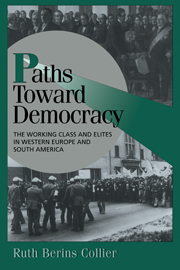Book contents
- Frontmatter
- Contents
- List of Figures and Tables
- Acknowledgments
- 1 Introduction: Elite Conquest or Working-Class Triumph?
- 2 Elite-Led Reform in Early Democratization
- 3 Political Calculations and Socialist Parties
- 4 Labor Action in Recent Democratization
- 5 Comparing the Patterns: The Working Class and Democratization
- Bibliography
- Index
5 - Comparing the Patterns: The Working Class and Democratization
Published online by Cambridge University Press: 05 June 2012
- Frontmatter
- Contents
- List of Figures and Tables
- Acknowledgments
- 1 Introduction: Elite Conquest or Working-Class Triumph?
- 2 Elite-Led Reform in Early Democratization
- 3 Political Calculations and Socialist Parties
- 4 Labor Action in Recent Democratization
- 5 Comparing the Patterns: The Working Class and Democratization
- Bibliography
- Index
Summary
The struggle for a democratic regime has been one of the most important processes of political change across two centuries of Western history. It has constituted a major political drama of the opening and closing years of the twentieth century, with substantial institutional continuity across the two periods: after evolving more slowly during the nineteenth century, the democratic institutions being adopted at the end of the twentieth century are remarkably similar to those that were the center of political struggle nearly a century earlier. European countries and their eighteenth- and nineteenth-century colonial offshoots have witnessed an extended experience with the struggle to adopt democratic institutions. Yet the processes through which such regime change takes place remain poorly understood, and they continue to be debated.
The goal of the present analysis has been to examine the role of the working class in the process of democratization and to do so in a way that integrates a literature that has been rooted alternatively in either class or strategic frameworks and has asserted (or implied) that the working class was alternatively the major, even decisive force in democratization or at most a rather marginal player in a process dominated by elite strategies. Democratization is a complex, multifaceted process involving a large variety of groups, actors, and interests, and following different trajectories. Several patterns can be distinguished, involving different combinations of class actors engaging in different arenas of action.
- Type
- Chapter
- Information
- Paths toward DemocracyThe Working Class and Elites in Western Europe and South America, pp. 166 - 198Publisher: Cambridge University PressPrint publication year: 1999



